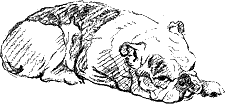 | |
Deaf Dog Education Action Fund |
| Home | | | FAQs | | | | | Resources | | | Rescue | | | You Can Help |
Clicker Training for Deaf dogs
He that would strike my dog would strike me.
- Scottish proverb
 Yes, you can clicker train a deaf dog! This page is not intended to give all the details of how clicker training works (see the recommended list at the end of the page for that), but rather how it can be adapted for use with deaf dogs.
Yes, you can clicker train a deaf dog! This page is not intended to give all the details of how clicker training works (see the recommended list at the end of the page for that), but rather how it can be adapted for use with deaf dogs.
At its most basic, the clicker is really just a "marker." It tells the dog that "what you did right there is correct and you will be rewarded for it." The click is usually followed by a treat of some type, but can also be a favorite toy (and playtime). The marker should be quick, accurate, and the same every time. For hearing dogs, the clicker is typically a small plastic box with a metal strip in it that makes a "cli-click" sound when pressed and released. People also use squeaky toys or specific words. (A word can be somewhat problematic because our voices can vary. "Yes" in a calm voice is different from "yes" in an excited voice, or even in a loud voice.) There is an interesting article about this at the Diamonds in the Ruff website called Click vs. Word. In order for the marker to be most effective, it must always (every single time) be followed by a reward that the dog likes (not something you think he should like, but something that he actually likes very much).
Obviously, a sound based clicker will not work for a deaf dog. There are a few choices for a substitute, each of which has both pluses and minuses. You will need to think about which will work best for you and your dog.
Hand Sign
 Using a hand sign can be the easiest, since, as they say, you always have your hands with you. Some people use a "thumbs up" and others use a "hand-flash" (closed hand, open quickly and then close again), but you can use anything you and your dog understand. One of the drawbacks to a hand sign is the same as using a word marker rather than a clicker with a hearing dog. For a hearing dog, the clicker has instant recognition, whereas a word has to be processed (and as stated above, voices can vary). A hand sign is much the same, it can vary slightly each time you use it, and the dog has to comprehend that this signal is different from any others that you use. You also will have to either get your hand in the dog's line of vision quickly, or he has to be looking at you to see the sign. It's very important to remember that a "click" is always followed by a treat, and not use this particular sign when you have no reward handy.
Using a hand sign can be the easiest, since, as they say, you always have your hands with you. Some people use a "thumbs up" and others use a "hand-flash" (closed hand, open quickly and then close again), but you can use anything you and your dog understand. One of the drawbacks to a hand sign is the same as using a word marker rather than a clicker with a hearing dog. For a hearing dog, the clicker has instant recognition, whereas a word has to be processed (and as stated above, voices can vary). A hand sign is much the same, it can vary slightly each time you use it, and the dog has to comprehend that this signal is different from any others that you use. You also will have to either get your hand in the dog's line of vision quickly, or he has to be looking at you to see the sign. It's very important to remember that a "click" is always followed by a treat, and not use this particular sign when you have no reward handy.
Flashlight
 A flashlight probably most closely approximates a sound-based clicker. It will be the same every time and it's quick. The best kind to use are generally the ones meant to be kept on a keychain, or small penlights (like a doctor would use). They are small and easy to carry and use. You want to find one that allows you to just push a button or squeeze the sides (sliding a switch or twisting part of the flashlight will take too long, and the timing will be off). The idea is that the dog is watching for the "flash," not the spot of light it makes, so she can respond to seeing the light out of the corner of her eye.
A flashlight probably most closely approximates a sound-based clicker. It will be the same every time and it's quick. The best kind to use are generally the ones meant to be kept on a keychain, or small penlights (like a doctor would use). They are small and easy to carry and use. You want to find one that allows you to just push a button or squeeze the sides (sliding a switch or twisting part of the flashlight will take too long, and the timing will be off). The idea is that the dog is watching for the "flash," not the spot of light it makes, so she can respond to seeing the light out of the corner of her eye.
There are drawbacks to a flashlight as well. If the dog is not looking at you at all, she may not see the light flash. The lights do not show up as much from a distance, or in very bright light (like a sunny day outside). You also need to be careful if you have a dog who is prone to compulsive behaviors (see our Other Links page for more information), since they can become more interested in chasing the light than anything else. There are also a few dogs who decide that flashing lights (such as from a camera) are scary, and they will not work well with a flashlight for a clicker either.
Vibrating Collar
 There are a couple of things to keep in mind if you want to use a vibrating collar as a clicker. The first is that you cannot use it for both an attention-getting device (the most common use, see our page on Training Your Dog With A Vibrating Collar for more information) and a clicker - it will be too hard for the dog to tell the difference. Another thing to consider is how much elapsed time (lag) there is between the time you push the button on the remote unit and when the dog feels it. Timing is very important to clicker training, and you could end up reinforcing the wrong behavior if there is too much lag time (which will make training more difficult). Even so, if you are training a dog that is both deaf and blind, this may be your best choice (although a distinct touch signal could work as well).
There are a couple of things to keep in mind if you want to use a vibrating collar as a clicker. The first is that you cannot use it for both an attention-getting device (the most common use, see our page on Training Your Dog With A Vibrating Collar for more information) and a clicker - it will be too hard for the dog to tell the difference. Another thing to consider is how much elapsed time (lag) there is between the time you push the button on the remote unit and when the dog feels it. Timing is very important to clicker training, and you could end up reinforcing the wrong behavior if there is too much lag time (which will make training more difficult). Even so, if you are training a dog that is both deaf and blind, this may be your best choice (although a distinct touch signal could work as well).
Laser Pointer
Laser pointers are not recommended. The dot is really too small to be easily visible unless the dog is intently watching for it (which is not what you want for most training). You can hurt your dogs eyes if you accidently point it directly at them. It might work well for a target (to direct the dog to a certain point), but it's not very useful as a clicker.
Further Resources
Websites
- Clicker Solutions
- The Well Mannered Dog - with Shirley Chong
- Click-L Home Page for the list, and contains a lot of good resources
- Clicker Train
- Classical and Operant Conditioning
- Clicker Tales
- Karen Pryor's Website - has a link to find a clicker trainer in your area
also see Training Archives for an article written by Karen Pryor for the AKC Gazette that mentions Maggie Mae and her mom Lin Gardinor, who were an inspiraton for many to try clicker training their deaf dog. - Learning About Dogs - Clicker Training in the UK
- Clicker Training for Deaf Dogs - a personal page
E-mail Lists
- Clicker Solutions E-mail List - a Yahoo!Groups List
- Clicktrain List - with Shirley Chong - directions for joining
- Click-L List - directions for joining
Recommended Reading
For a list of clicker training books, see our Resources area.
Recommended Videos
| Home | | | FAQs | | | | | Resources | | | Rescue | | | You Can Help |
© Copyright DDEAF, 1998-2024

